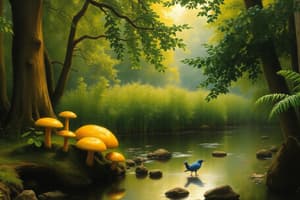Podcast
Questions and Answers
Why can't fungi do photosynthesis?
Why can't fungi do photosynthesis?
Fungi lack chlorophyll
What do decomposer fungi feed on?
What do decomposer fungi feed on?
Dead organic material
Give an example of a fungus that feeds on living organisms.
Give an example of a fungus that feeds on living organisms.
Mushrooms
What is taxonomy?
What is taxonomy?
Explain why fungi are not classified as plants.
Explain why fungi are not classified as plants.
How did Aristotle classify organisms?
How did Aristotle classify organisms?
What are the three domains of living organisms?
What are the three domains of living organisms?
What is unique about organisms in Domain Archaea?
What is unique about organisms in Domain Archaea?
What are the characteristics of organisms in the Kingdom Fungi?
What are the characteristics of organisms in the Kingdom Fungi?
How do fungi obtain their nutrients?
How do fungi obtain their nutrients?
What sets fungi apart from plants and animals?
What sets fungi apart from plants and animals?
Give an example of a common infectious agent that belongs to the Kingdom Fungi.
Give an example of a common infectious agent that belongs to the Kingdom Fungi.
Flashcards are hidden until you start studying
Study Notes
Fungi and Photosynthesis
- Fungi lack chlorophyll, the pigment necessary for photosynthesis.
- Chlorophyll enables plants to capture light energy and convert it into chemical energy.
Decomposer Fungi
- Decomposer fungi feed on dead organic matter, such as fallen leaves, decaying wood, and animal carcasses.
- They break down complex organic molecules into simpler substances, releasing nutrients back into the ecosystem.
Fungi Feeding on Living Organisms
- Parasitic fungi obtain nutrients from living organisms, often causing harm to their host.
- An example is the Cordyceps fungus, which infects insects and controls their behavior.
Taxonomy
- Taxonomy is the science of classifying organisms into groups based on their shared characteristics.
- It involves naming, describing, and organizing organisms to understand their relationships and evolutionary history.
Fungi vs. Plants
- Fungi are not classified as plants because they lack chlorophyll and cannot produce their food through photosynthesis.
- Fungi have cell walls made of chitin instead of cellulose, which is found in plant cell walls.
Aristotle's Classification
- Ancient Greek philosopher Aristotle classified organisms based on their physical characteristics, placing them into two main groups: plants and animals.
Domains of Living Organisms
- The three domains of living organisms are Bacteria, Archaea, and Eukarya.
- This classification system reflects the evolutionary relationships among organisms at a fundamental level.
Domain Archaea
- Organisms in Domain Archaea are known for their ability to thrive in extreme environments, such as hot springs, highly saline environments, and acidic conditions.
- Their unique biochemistry and genetic makeup set them apart from bacteria and eukaryotes.
Kingdom Fungi
- Fungi are heterotrophic organisms, meaning they obtain nutrients from other sources.
- They are eukaryotic, having cells with a nucleus and other membrane-bound organelles.
- Fungi reproduce both sexually and asexually, and their bodies are typically composed of thread-like structures called hyphae.
Nutrient Acquisition in Fungi
- Fungi obtain nutrients through absorption.
- They secrete enzymes that break down complex organic molecules into simpler substances, which they then absorb.
Distinguishing Fungi
- Fungi are distinct from plants because they cannot produce their food through photosynthesis.
- They are different from animals because they have rigid cell walls and obtain nutrients by absorption.
Common Infectious Agent
- Candida albicans is a common fungus that can cause infections in humans, such as yeast infections and thrush.
- It typically lives harmlessly on the skin and mucous membranes, but can become pathogenic under certain conditions.
Studying That Suits You
Use AI to generate personalized quizzes and flashcards to suit your learning preferences.




